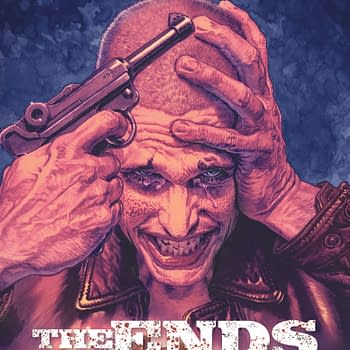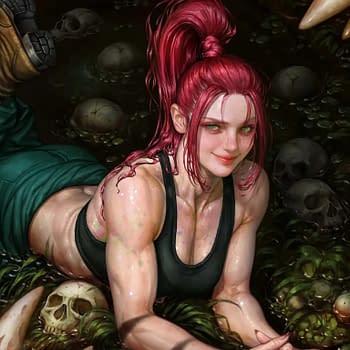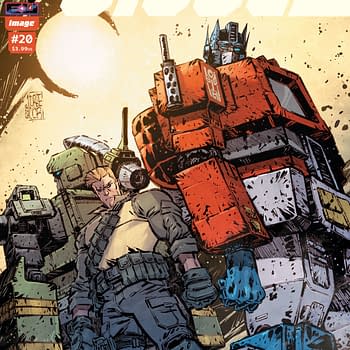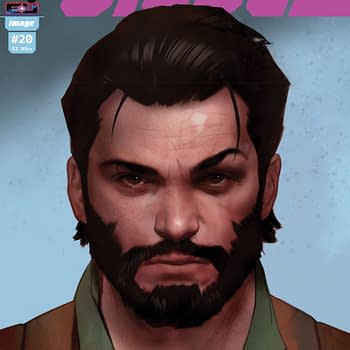Posted in: Comics, Recent Updates | Tagged: Cat Staggs, Comics, entertainment, graeme manson, idw, Jody Houser, john fawcett, orphan black
Engineering IDW's Orphan Black – Jody Houser And Cat Staggs In The Bleeding Cool Interview
I watched the premier of the fledgling BBC America show Orphan Black with some interest, and perhaps a little skepticism, two years ago, and remember exact points at which the show convinced me that it was both thought-provoking and relevant to modern life.
The fact about the show that usually surprises people and captures their attention is that the same actress, Tatiana Maslany, plays the role of all of the "clones" who are locating each other and pursuing the mystery of their birth in the narrative. But over time, you often forget about that aspect of the show because you become so engrossed in the strange and vivid characters the show presents. Because the Orphan Black story operates at multiple points in time from multiple perspectives, and works to some degree as a mystery with sudden significant reveals, following the lives of central clone Sarah Manning and her sisters works very well in comics format. That is, if the creative team can handle the complexity of it.

Issue #1 of Orphan Black, which had a whole host of special covers by Staggs, even issued as a boxed collector's set (basically all of the non-photo covers) sold out, and was featured as an exclusive in Loot Crate. Issue 2, which focuses on Helena, has also done very well, and both issues took us into turning points for each character that are entirely new experiences for readers who also watch the show. Issue #1, featuring Sarah, brought insight into her perception and involvement in Beth's death. Issue #2 took us into Helena's childhood and training. Now, this week, we see the arrival of Issue #3 starring a character who is not only the "favorite" clone of both Houser and Staggs, but also among fans. The astonishingly manipulative, powerful, funny, and sometimes tragic soccer mom Alison takes the stage. This is really an issue of the comic not to miss, as Staggs joins the creative team on a new level for interior art alongside Alan Quah, with colors by Chris Fenoglio. We will learn so much more than we ever guessed about Alison's relationship with her husband Donnie and what makes the most "layered" of the clones tick, often with great comedic affect.
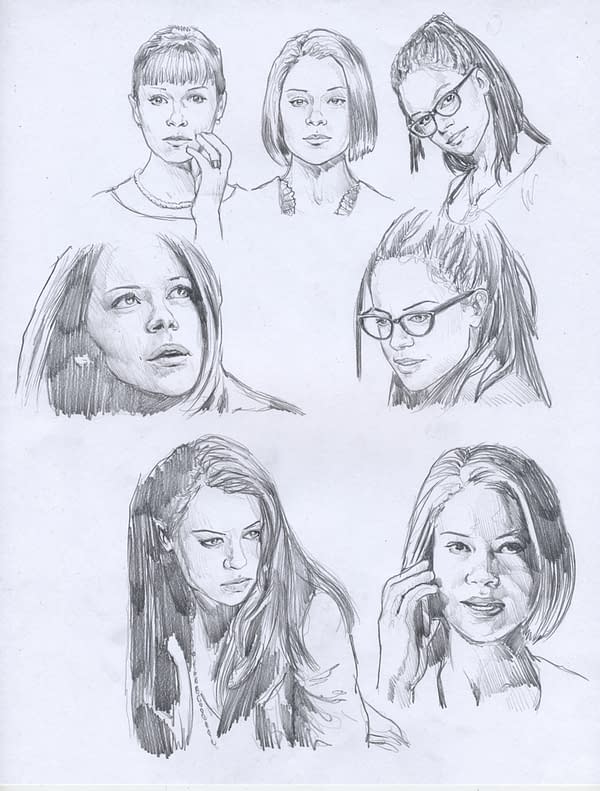
I was able to talk to both Jody Houser and Cat Staggs at WonderCon about the series, and we even ventured into discussing the role of Alison and Issue #3. During the interview, Houser and Staggs were very much in demand for signing and discussions with fans, bringing home not only the popularity of Orphan Black, but how curious fans remain about this universe and how much of the story remains to be told. In the meantime, Season 3 of the show has also arrived on BBC America and a new circle of military-trained male clones have been introduced.
Let's hear about Houser and Staggs' experiences working on the book so far:

CS: Yes, I did all the different covers for #1 aside from some photo variants.
HMS: And there's a special boxed set for #1 with those variant covers, all by you?
CS: The actual boxed set cover art is by Nick Runge, which was the promo art for the series when it was announced that IDW had licensed the property back at San Diego Comic Con in 2014.
HMS: That one is actually the cover of Bleeding Cool Magazine #15, our Female Heroes issue, and we were so proud to have it. Jody is interviewed in that issue as well.
Now, Cat, how difficult is it to present all of these characters who essentially look alike in a different enough way that viewers are going to be able to distinguish them fully?
CS: Well, aside from the obvious, which would be things like hairstyles and clothes being different. But there are a few episodes of the show where Sarah impersonates other clones as well, and this gave me a whole new appreciation for Tatiana's acting abilities because of the subtlety of her facial expressions. The minute changes that she makes, such as the turn of the corner of her mouth, or just the way she rests her eyes, or cocks her eyebrow—those things automatically make her Alison or Helena. The trick for me was trying to capture that and not just keep drawing Tatiana.
HMS: I can't imagine how difficult that must be for an artist. I really can't.
CS: It took me a lot of studying her face as each character to figure out what facial changes she makes for each one, and then it was just a matter of applying them to the characters on the page.
HMS: Because you're presenting them in such a hyper-real fashion as well, with a painted effect, it almost seems like you're doing formal portraits of them. Were you given the freedom to choose backdrops and backgrounds on the covers?
CS: Yes, that was pretty much up to me. They wanted the solo covers (those that show each clone individually) to eventually link together, and that's the end result. Each of them will link together to create a kaleidoscope effect.
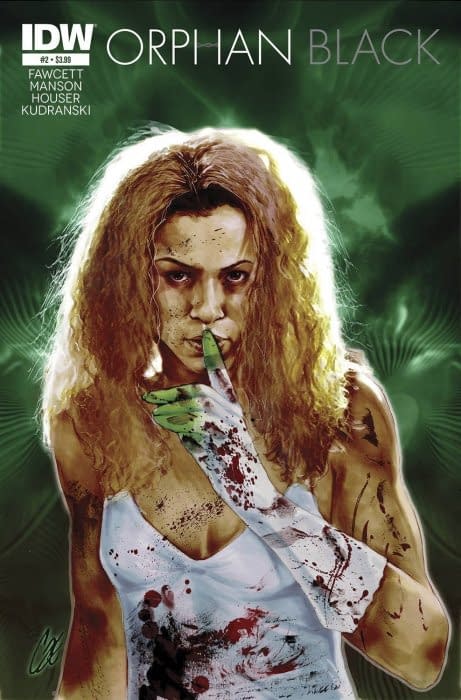
CS: For the costumes, I wanted to pick something iconic for each clone. They each have a specific look, but in many press pictures, they actually have iconic outfits on. So, I followed that lead on the solo covers. For the variant covers, that was even more fun because I got to town with what I included. I'm torn because my favorite of the variants is either Katja with the broken glass or the Allison "Gothic" one, which is Allison and Sarah. When I look at it, I see "American Gothic" for some reason.
HMS: What sort of media do you use to compose your covers?
CS: I use Copic marker and then Photoshop. Basically, I draw in black and white and then do all the colors in Photoshop. I basically do all the figures in grayscale and then the colors and backgrounds are done in Photoshop.
Jody Houser: But even your convention sketches are heavy on the gradients. That's kind of your signature.
CS: Yes, true.
HMS: Jody, I am in the unique position of getting to ask you all the questions that occurred to me after we did our magazine interview. And now having read a couple of issues of the comic, I have even more. I wanted to ask you about relationships in the comics, since they seem to be a major focus.
JH: For me, the relationships are a core element of the show. They are building this sisterhood they didn't have it growing up. Family is what they need for many of them. A lot of them have parental issues because of their adoptive parents or because they can't necessarily be parents if they want to be, aside from Sarah and Helena. I think the family relationships are really interesting, particularly in Issue #2 where we start to play on Helena and Maggie's relationship. Helena came from such an unhealthy place, but I like that there was someone who was there for her, though still not in the way they should have been. Maggie was supporting Helena in her youth, but still enabling all the abuse that happened.
HMS: And that's very shocking stuff for readers in that issue, because that's all information we did not learn from the show. It's new information about Helena's past.
JH: Yes. A lot of that came from John [Fawcett] and Graeme [Manson], and is stuff they have worked out. They have their show Bible with very detailed backgrounds for the characters. You'll see some of that in Issue #3 with Allison. They have the whole path of her relationship with Donnie mapped out. That's not to say that I didn't have any input. They are actually very flexible about a lot of things. I love the fact that they let me include Beth's thoughts before she jumped in the comic.
HMS: Yes, that was amazing!
JH: I get really excited about including things like that.
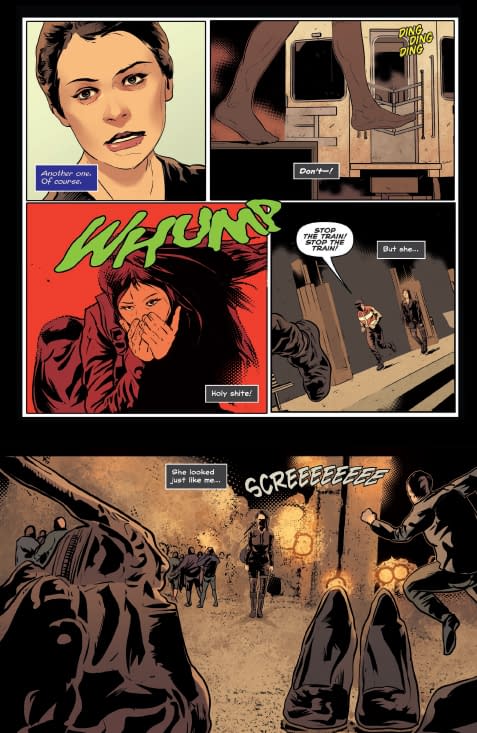
JH: Yes, I think so. I haven't worked on her issue yet, but I think that Cosima is the one who is going to be most open to forming connections. Because she finds her sisters fascinating in terms of science, and wants to figure out what makes all of them tick, it's almost like she has a buffer there that helps her to be, as my mom calls her, "the nice one". Cosima is my mom's favorite because she's "the nice one".
HMS: There's a kind of eeriness to that side of her in the show when she is diagnosing herself with scientific detachment.
Does writing these comics seem structurally complex to you? The first two comics each move around a lot in time within their narrative, for example. Well, that's an understatement really. There are these small units of time being used to convey pockets of information.
JH: It's funny because almost all my anthology work is incredibly non-linear. At this point, I might not know how to write a linear story anymore. So this is actually perfectly comfortable for me. I think we've actually pulled back on some of that, even. Because I'm so far into the non-linear comic storytelling, whereas John and Graeme are coming from TV writing, and therefore are not as used to the format. Part of the collaboration has been exploring the different storytelling techniques that we can use in comics that they can't use on the TV show. I think that's probably the case with a lot of licensors.

JH: Yes, I think in the second issue, for instance, using grayscale for the flashbacks made things stand out even more clearly than they did in the first issue. So even things like color techniques are tools that can be used to help distinguish time jumps. It's harder to that in TV. You could move to black and white for flashbacks, but that has an artificiality to it, whereas people who read comics are used to it.
HMS: Can I ask you all a less serious question? Do you have a favorite clone?
JH: My favorite is Alison, but only by a tiny margin. Then Helena's like 1.5 and Cosima's like 1.75. I like Alison especially because I feel that in another type of show, she'd just be comic relief, and we wouldn't get to see her depth of character. She's a character who is living as a very constructed suburban person. You can tell how carefully constructed that persona is in the precision of her movements and the way she holds herself, as something that she's working toward. I love that we get to explore that. That's the great part of having a female ensemble, that we can have such a diversity in characters.
CS: Alison is my favorite.
HMS: You too!
CS: She is a perfect onion, she is so layered. And you can just that she's going to explode at any moment. Watching her epic meltdown through the course of Season One was the most beautiful thing I've ever seen. There was no topping that.
JH: My favorite moment is during the torture scene with Donnie when she's spinning the rack with all the different scrapbooking scissors, then pulls one out, and thinks, "I don't know what to do with this", and puts it back. (Laughter) That was probably my favorite moment of the entire season.
CS: She's just brilliant. I could never be friends with her, but she's brilliant.
Cosima you could be friends with. With Allison, you just sit down with a bucket of popcorn and just watch her go.
JH: She's the person you don't hang out with in real life, but friend on Facebook to watch…
CS: Yes! And just watch the feed go by.
JH: All the craziness.
HMS: That is so, so true.

CS: Drawing her is all about her eyes. There's always something about her that suggests she's always three steps ahead. I hope I'm capturing that on the interiors in Issue #3. She's always several steps ahead and she clicks and changes in a second. The expression in her eyes changes.
JH: Cat draws really good crazy Alison eyes!
JH: I'm having so much fun drawing her.

JH: Oh, yes! And there are some theater references in Issue #3, I'll say that, including my favorite line that I've written in the entire series so far.
CS: I think I drew my favorite panel ever on that issue the other day, too!
HMS: Well, this season we have the male clones, too. There could be another comic series like this one focused on them sometime. Just saying.
JH: Or even a Felix one-shot. That would be great. I'm sure there are going to be a lot more stories that would work great in comics coming out of the show.
HMS: Last question: Was there anything that you discovered while working on the comic that surprised you and affected you as a fan?
JH: I have a good example from the first issue. There's a scene in the first season of the show where Sarah confronts Paul and implicates him in Beth's suicide. But at the same time, you realize that she knows a lot about this, and you wonder where she got the information from. Issue #1 was a perfect opportunity to show Sarah discovering the video that Beth had made for the other clones, and that explains where she got all her information from that led to her suspicions of Paul. That was a question I didn't fully realize that I had, but once I was able to answer it, that was awesome.
CS: Well, not exactly, but I can't really say much about Issue #3 yet, which we're working on. I think fans are going to be super-excited about some of the content in that, but I'll leave it at that.
Orphan Black #3 featuring Alison is arriving this Wednesday, May 6th!












